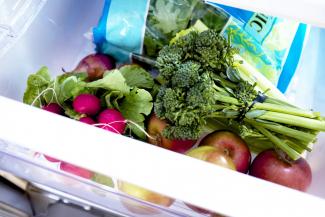Best Practices: Washing and Storing Fresh Produce

Eating a healthy diet starts with following the U.S. Department of Agriculture’s MyPlate Plan.
A key component is filling half your plate with fruits and vegetables. As you transition to buying and serving more fresh fruits and vegetables, it’s important to wash and store your produce safely. These steps prevent foodborne illness, preserve your produce longer and stretch your food budget further.
As we have noted in previous blogs, fresh fruits and veggies are among the most nutrient-dense foods on the planet. They’re packed with vitamins, minerals, fiber, and antioxidants. Whole plant foods offer nothing but benefits for your family’s health, so they’re certainly not something you want to waste.
Following a few best practices for preparing, washing, and storing produce according to its unique needs will keep it fresh as long as possible.
It all starts with selection. Here are some tips to choose the best vegetables and fruits.
- • Give hand-held produce (e.g., avocados, tomatoes, apples, peaches) a light squeeze to check for any bruising or softness beneath the surface that could be a sign of rotting or quickly diminishing shelf-life.
- • Check leafy greens for wilting or slimy bits.
- • Check celery, asparagus, leeks, and other stalky vegetables for firmness.
- • Look at containers of berries or grapes from different angles for signs of visible mold, as this can quickly spread throughout the container.
When it comes to storage, avoid washing and cutting everything right away. This can shorten the lifespan of certain produce. Plus, washing items too early can create a moist environment perfect for mold and bacterial growth. The exception to this rule is leafy greens, which can last longer if you wash and dry them right away and store them in the fridge. These can either be kept in air-tight bags with a paper towel or chopped and kept in a salad spinner, ready to pull out and eat.
Additional tips for washing fruits and vegetables include:
- • For firm produce such as pears, apples, potatoes and squash: use a produce brush to remove any unwanted substances from the outside.
- • Even produce that has a skin that you won’t be eating needs to be washed. This is because germs on the exterior can be transferred to the edible portion when you slice them open or peel them with your fingers.
- • For produce that is more delicate (berries and mushrooms, for example,) rinse these under a gentle stream of cool water and use your fingers to remove grit. These may also be soaked in cold water for a few minutes to help remove dirt from crevices, before draining and rinsing with clean water. Make sure to do it right before eating– otherwise they’ll get soggy.
- • After you’re done washing produce, dry it gently using a cloth or paper towel. For delicate produce, these can be rolled on a towel to help remove moisture.
How long can we store them for? When it comes to fresh produce, there are some general guidelines that we can follow:
2-5 days: Cucumbers, tomatoes, berries, peaches, plums, mangos, ripe bananas, leafy greens that are often cooked (example: bok choy, spinach, kale, Swiss chard), and fresh herbs.
5-7 days: Cruciferous veggies, green beans, ears of corn, mushrooms, lettuce, cherries, oranges, grapes, pears, bell peppers, eggplant, summer squash, and small potatoes.
1-2 weeks: Butternut squash, apples, lemons, limes, large potatoes, and other root vegetables.
To enhance shelf life, we can store produce in two ways:
- On the counter: Whole and un-cut citrus fruits, bananas, melons, pineapple, winter squash, potatoes, onions, and garlic.
- In the fridge: all other produce, including cut-up versions of those listed above.
Tomatoes are the exception to this rule. To store them, it depends on the level of ripeness they have. If they are over-ripe, they will go bad quickly if stored on the counter. Is preferably to store them in the fridge.
Adopting good storage habits helps ensure you utilize all of your produce before it spoils. Make a weekly meal plan and shopping list, set realistic goals for what produce your family will actually eat, and enjoy!.
